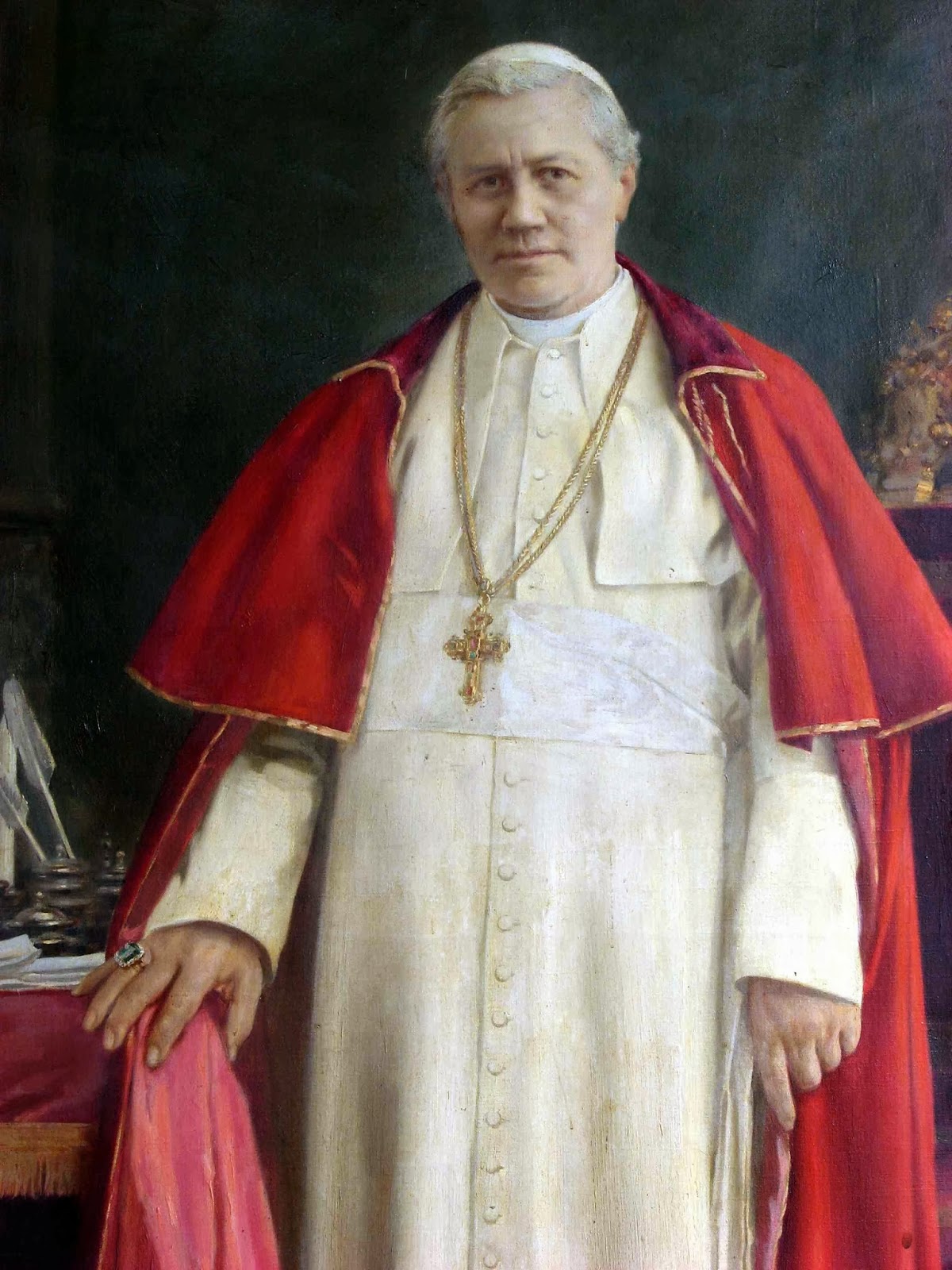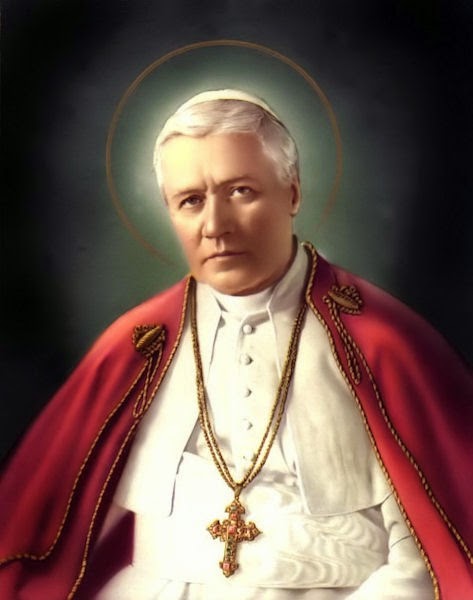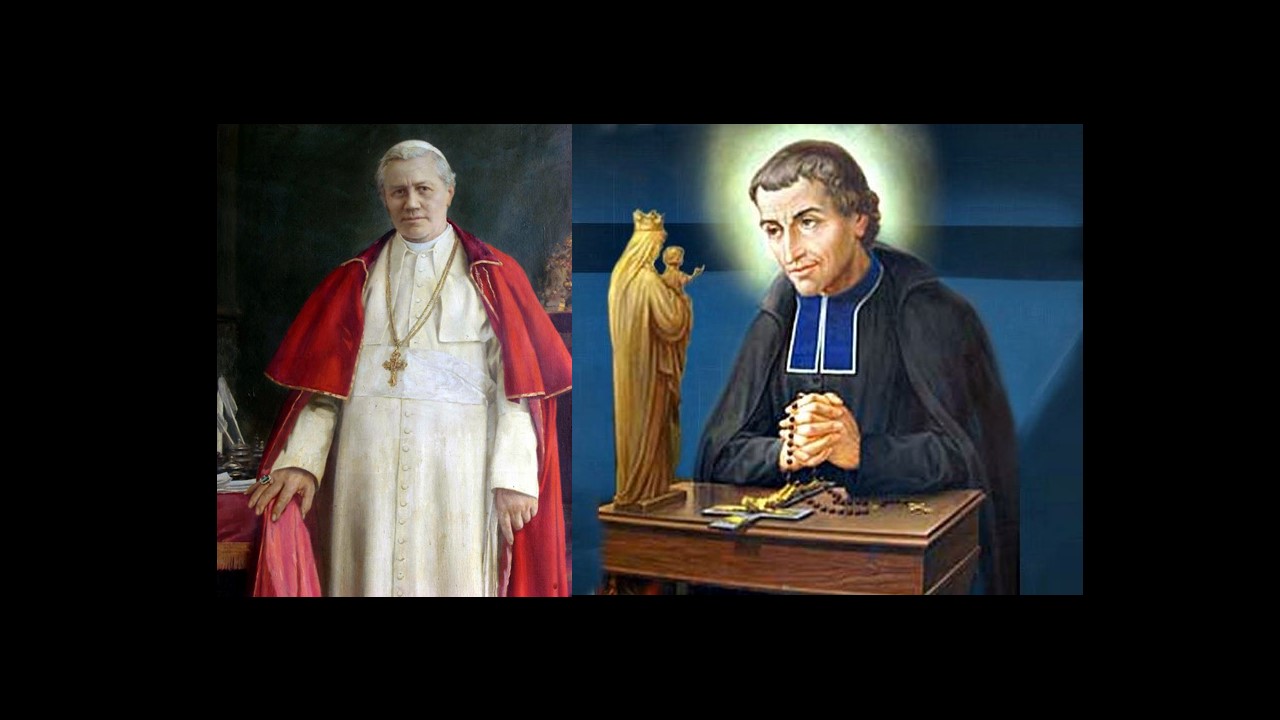Saint Pope Pius X and His Devotion to Mary
Fr. Frank A. Setzer, SMM
I have always had a great devotion to our Blessed Mother and I have always felt that I grew up under her protection. The shrine near Riese which I love is hers; my church at Mantua [(northern Italy, between Milan and Padua)] is under her protection. And now I am going to Venice where, at every street corner, on every island, there are monuments to her.” Thus spoke Cardinal Sarto, the future Blessed Pope Pius X, after his elevation to the cardinalate when taking possession, at Rome, of his titular church of St. Bernard, the singer of the praises of Mary.
And, indeed, from the regular Sunday afternoon visits of the peasant boy to the shrine of Our Lady outside his native Riese, to the daily visits of the Supreme Head of Christendom to the grotto of Our Lady of Lourdes in the Vatican gardens, there is manifest in the life of Joseph Sarto a constant expression of genuine and effective love for Mary. He is the Pope of the Eucharist, the Pope of Christian Instruction, the Pope of Anti-modernism; with equal reason may we call him the Pope of Mary.
No picture of his life is complete without mention of the shrine of the Madonna delle Cendrole and the place it occupied in his memory and affection throughout life. His frequent childhood pilgrimages to this chapel, located a short distance from his home, were repeated each time he returned to visit his home, as a priest, bishop and cardinal. As Patriarch of Venice he restored and beautified it; as Pope he wrote a letter to his co-villagers, commending it to their continued care. On the day of his coronation, of a delegation from Riese he asked for prayers in the name of the Madonna delle Cendrole. This little shrine was dedicated to Our Lady of the Assumption. Perhaps it was there that was born in him that love for this prerogative of Our Lady that inspired his reply in this episode: “Pius IX was the Pope of the Immaculate Conception; Leo XIII of the Holy Rosary,” was said to him one day; “May Your Holiness . . . ” ”Be the Pope of the Assumption,” completed Pius X.
As a seminarian, we find him, on vacation, offering to Mary the daily homage of the recitation of her Little Office. As a priest, he preached Mary in his numerous sermons, introduced and promoted the pious practice of the month of May. When his nomination to the episcopacy arrived, it was before the altar of the Blessed Mother that he received it and one of the first things he did after his consecration was to make a pilgrimage to the shrine of Our Lady of Loreto. Chief among the simple furnishings, of his study, even as Supreme Pontiff, was always either a statue or a picture of Our Lady.
While Bishop of Mantua, he revived popular interest in an ancient shrine of Our Lady of Grace situated a few miles from his episcopal city. Through his efforts the Franciscans returned as its custodians and pilgrimages were renewed in large numbers. We are told that during those years, except for an occasional visit to his aging mother, his special and only recreations were his frequent visits to this shrine and on the occasions of pilgrimages he would spend hours there, himself helping in the administration or the sacraments.
Just before leaving for the conclave that was to elect him to the See of Peter, he asked that special prayers be offered at this altar of Our Lady of Grace so she might protect him on his journey. During the conclave, when he realized that the wishes of the assembled cardinals were inevitably converging on him, he protested his unworthiness and, after he had spoken, he withdrew to the Pauline Chapel and fell upon his knees before the picture of Our Lady of Good Counsel.
Among the official papal documents issued during the eleven-year reign of Pius X, we count ninety-five treating of Marian subjects.
In his first encyclical, “E Supremi Apostolatus Cathedra,” issued August 4, 1903, he set forth the whole program of his pontificate which he epitomized in this motto, “Restore All Things in Christ.” The means he proposed to use to accomplish this was the Blessed Virgin Mary. He returned to this theme more at length in 1904, in his immortal encyclical, “Ad Diem Illum Laetissimum,” commemorating the fiftieth anniversary of the definition of the dogma of the Immaculate Conception. “The chief reason,” he wrote, ”why (this) anniversary should arouse a singular fervor in the Christian people is to restore all things in Christ .. . For who does not know that there is no surer or easier way than Mary for uniting all persons with Christ and obtaining through Him the perfect adoption of sons that we may be holy and immaculate in the sight of God? . . . It is necessary to recognize His most holy Mother as the partaker of the divine mysteries and , in some manner, as the guardian of them, and that upon her as upon a foundation, the noblest after Christ, is built the edifice of faith for all ages.”
This same idea we find recurring frequently under his pen, in such documents as: “Abbiamo Appreso, ” September 14, 1903, a letter addressed to the Bishop of Lourdes; encyclical on the tercentenary of the canonization of St. Charles Borromeo, May 26, 1910; the encyclical, “Communium Rerum,” April 21,1909; the encyclical, “Haerent Animo Penitus, ” August 4, 1908.
Devotion to Mary, then, in the mind of Pius X, is not just another pious exercise, a work of supererogation, a side-chapel, as it were, in the great Church of Christ. It is an integral part of the economy of salvation, the means God chose to come to us, the means we are to use to return to Him. It is the sure and easy way of restoring all things in Christ. For Mary is the most ”competent guide and teacher for knowing Christ. … No one is more powerful for uniting men with Christ … Through Mary we obtain more easily the life of which Christ is the source and the beginning. … She is the mother of the members of Christ, which we are . . . She merited to become in a most worthy manner the Reparatrix of the lost world and, consequently, the Dispenser of all the gifts that Jesus acquired for us by His Death and Blood.” (Ad Diem Illum)

St. Pope Pius X

Editors Note: Queen of All Hearts’ archive is rich in spiritual treasures. From time to time we will also pull out some rich historical treasures as well, like this article. This article was originally written a few months (September 1951) after the pope was beautified. Historically, there is a great connection to St. Pope Pius X and Queen of All Hearts. Pius X (Pope between 1903 and 1914) not only erected the Confraternity of Mary Queen of All Hearts (later renamed The Association of Mary, Queen of All Hearts), but Pope Pius wished to be inscribed among its members. He was the first priest to enroll into the Confraternity in 1908. Of him, all our Lady’s slaves of love and members of QoAH may say proudly: He is One of Us!
This article presents the Marian side of Saint Pope Pius X.
And, in truth, how else could the role of Mary be conceived by one who was so penetrated with the teaching of Montfort; who had read and re-read ”True Devotion to the Blessed Virgin, ” who praised it so highly and granted his Apostolic Benediction to all who would read it;
And, in truth, how else could the role of Mary be conceived by one who was so penetrated with the teaching of Montfort; who had read and re-read ”True Devotion to the Blessed Virgin, ” who praised it so highly and granted his Apostolic Benediction to all who would read it; who acknowledged having perused it once more before composing his eminent Marian encyclical; who made the total consecration to Mary according to St. Louis de Montfort, had himself enrolled in the Confraternity [(The Association)] of Mary, Queen of All Hearts, and the Priests of Mary, both of which have as their aim the practice and spreading of the Montfortian consecration?
Seeking to understand the hidden part devotion to Mary played in his life, we can look to no better source of information than his own words; and in his own explanation of what devotion to Mary should be we find the definition of what his devotion to her was! ”The only genuine devotion to the Mother of God is that which flows from the heart,’ and the acts of the body, when separated from the soul, have absolutely no value or utility in this matter. It is necessary that the acts of the soul should aim solely in making us obedient in all things to Mary’s Divine Son. For if the only genuine love is that which is capable of uniting wills, certainly our will and the most holy Mary’s must be the same – that of serving the Lord Christ. For . . . the most prudent Virgin addresses us, ’Do whatever He tells you.’ But the command of Christ is this, ’If thou wilt enter into life, keep the commandments.’ (External celebrations ) must be accompanied by the consent of the will ,’ (otherwise ) we shall have mere formalities which present only the semblance of religion . . .If the devotion (one ) professes towards the most Blessed Virgin does not keep him from sin, it is a lying and deceptive devotion, since it lacks its own natural fruit ,,, If anyone should wish, as we ought to wish, that his devotion be worthy and in every way perfect, he must make progress and use all his energy to imitate her example. (She) is the closest copy of Christ that human nature is capable of . . . Her children should not fail to imitate any of the virtues of their most holy Mother. … above all, her faith, hope . . . and charity toward God and man” (Ad Diem Illum)
That True Devotion to Mary was thus effective imitation, and not only sterile admiration, of her virtues was the subject of his frequent admonition, notably in the messages addressed to the participants of the Marian Congresses at Rome and Freiburg. Mary ”is the beautiful mold where Jesus was naturally and divinely formed” and ”he who is cast in this mold is presently formed and molded in Jesus Christ” (T.D. #219). Pius X was cast in this mold. He possessed the humility and the simplicity that made him submissive to the workings of divine grace and gave Mary a free hand in molding him to the model of her Divine Son. He was one of the great saints of the latter times foretold by Montfort, “full of grace and zeal , chosen to match themselves against the enemies of God who rage on all sides, . .. singularly devout to our Blessed Lady, illumined by her light, led by her spirit, supported by her arm . . . with one hand that shall fight and overthrow heretics and sinners and with the other hand build the mystical city of God; they will consecrate themselves to her service, as subjects and slaves of love; by their words and example, they shall draw the whole world to True Devotion to Mary.” (TD. 48,55)
WONDERS OF GRACE
Since making this act of consecration it has really done wonders for me along the spiritual line. It is something one really cannot express in words. Certainly our sweet mother rewards and takes care of those who give themselves to her in a special way. The book THE SECRET OF MARY is my daily companion. (Sr. M. A., C.S.J., St. Louis, Mo. )



